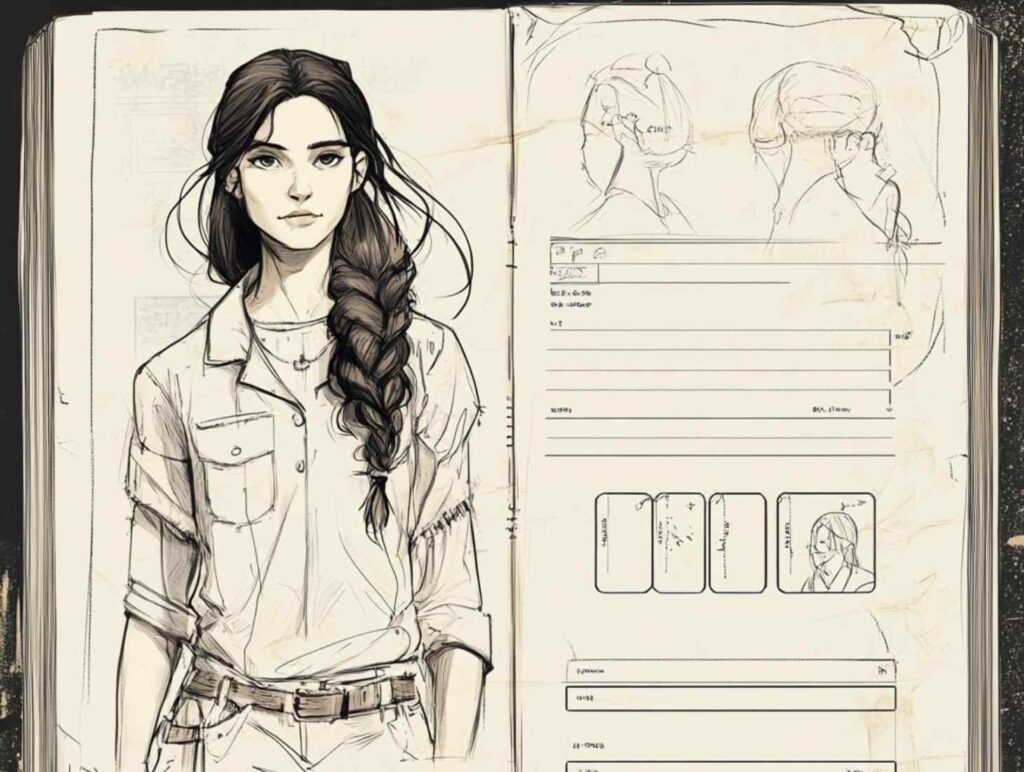Imagine creating a character so vivid, they leap off the page and into the hearts of readers. This magical transformation starts with character sheet planning, an indispensable tool in crafting compelling stories.
Have you ever wondered how some authors breathe life into their characters, making them unforgettable?
The secret lies in meticulous planning and understanding the core of your character’s journey. In this guide, we’ll explore the essentials of character sheet planning, offering insights into building characters that resonate and endure.
Understanding Character Sheet Planning
The art of character sheet planning is akin to being an architect of personalities. It’s about laying the groundwork for who your characters are, what drives them, and how they evolve.
This process not only shapes your story but also ensures consistency and depth. A well-crafted character sheet is like a blueprint, guiding you through the labyrinth of fiction writing tips and strategies.
Feeling lost with your debut novel?
Fiverr Pro connects you with expert editors, designers, and marketers – everything you need to get your book ready for success!

The Importance of Character Profiles
A character profile is more than a mere collection of traits; it’s the soul of your character. It helps you delve into their psyche, exploring their history, motivations, and unique quirks.
Consider it a personal diary, filled with secrets that might never make it to the page but influence every action and reaction. By understanding these intricacies, you pave the way for richer plotlines and dynamic interactions.
Common Character Types in Fiction
Fictional worlds teem with diverse character types, each playing a crucial role in the narrative tapestry. From the heroic protagonist to the enigmatic anti-hero, these archetypes serve as familiar anchors for readers.
Understanding these roles helps in positioning your characters effectively within the story. Here’s a quick look at some common types:
- Protagonist: The main character driving the story forward.
- Antagonist: The opposing force challenging the protagonist.
- Confidante: A trusted ally who provides insight and support.
- Foil: A character contrasting with the protagonist to highlight particular qualities.
- Love Interest: A character whose relationship with the protagonist adds depth and tension.

Essential Elements of a Character Sheet
To create a character that feels real, you must include key elements in your character sheet. These elements provide a comprehensive view of your character’s world, allowing for seamless integration into the narrative. Let’s explore these components in detail.
Basic Information to Include
Start with the basics to anchor your character in the reader’s mind. This includes details like name, age, and physical description. Consider how these aspects might affect their interactions and perceptions.
For instance, a character’s age can influence their worldview and decisions, while their appearance might affect how others perceive them.
Google Docs is for notes. Scrivener is for novels. Upgrade your writing game and try it for free today!

Character Traits and Background
Dive deeper into your character’s personality by outlining their traits and backstory.
Are they optimistic or cynical?
What past experiences have shaped their current behavior?
These elements add layers to your character, making them relatable and intriguing. A well-rounded background gives context to their actions and decisions.
Goals, Motivations, and Conflicts
Every character needs a purpose, a driving force that propels them through the story. Identify their goals and motivations, as these are the catalysts for action.
Equally important are the conflicts they face – both internal and external. These challenges create tension and drive the narrative forward.
| Element | Description |
| Goals | The desired outcomes or achievements for the character. |
| Motivations | The reasons behind the character’s goals. |
| Conflicts | Obstacles that hinder the character from achieving their goals. |

Exploring Character Arcs
Character arcs are the transformative journeys that characters undergo throughout the story. They are the heartbeats of your narrative, showing growth, change, or even regression. A well-developed arc can turn a good story into an unforgettable one.
The Journey of Change
Characters should not remain static; they must evolve in response to the events around them. This evolution can be subtle or dramatic, but it must feel authentic.
Consider how the challenges they face alter their perceptions and beliefs. A successful arc is one where the character emerges transformed, having learned something vital about themselves or the world.
To craft a compelling character arc, ensure that the change is gradual and believable. Use pivotal moments in the plot to trigger introspection and growth. This approach keeps readers engaged, as they witness the character’s transformation unfold organically.
No marketing platform? No social following? No problem!
Publisher Rocket helps you market your debut novel like a pro.
It’s a gamechanger for debut authors – try it today!


Creating Dynamic Characters
Dynamic characters are those who exhibit significant development over time. They react to circumstances, learn from experiences, and adapt accordingly.
These characters are often the most memorable because they reflect the complexities of real people. Ensure your characters have room to grow by placing them in situations that challenge their core beliefs.
The Role of Flaws and Strengths
Flaws and strengths are essential in shaping a character’s journey. Flaws humanize characters, making them relatable and authentic.
Strengths, on the other hand, are the tools they use to overcome obstacles. The interplay between these elements creates a rich tapestry of conflict and resolution, driving the narrative forward.

Crafting Engaging Relationships
Relationships are the threads that weave characters into the fabric of your story. They add depth and dimension, influencing character development and plot progression.
Whether it’s a budding romance or a bitter rivalry, relationships shape your characters’ actions and decisions.
Building Connections Between Characters
Connections between characters should feel organic and genuine. Consider their shared history, mutual goals, and underlying tensions. These connections can serve as catalysts for character growth and plot twists.
A well-crafted relationship adds emotional weight to your narrative, keeping readers invested in the characters’ journeys.
Character Interactions and Development
Interactions between characters reveal their personalities and drive the plot. Dialogue, body language, and reactions all contribute to character development.
Pay attention to how characters communicate, as this can highlight their differences and similarities, fostering deeper connections or conflicts.
When crafting interactions, ensure each character has a distinct voice. This not only differentiates them but also enriches their relationships.
Unique dialogue patterns and speech styles can reveal much about a character’s background and personality.

Utilizing Character Sheets in Your Writing Process
Character sheets are invaluable tools in the writing process strategies. They provide a reference point, ensuring consistency and aiding in plot development. By organizing your characters’ information, you streamline your writing and enhance creativity.
Tips for Effective Character Sheet Usage
To maximize the benefits of character sheets, keep them updated and detailed. Refer to them regularly to maintain consistency and coherence.
Use them as a springboard for brainstorming new plot ideas and character interactions. They can also serve as a checklist, ensuring you cover all necessary aspects of character development.
Incorporating Feedback and Revisions
Feedback is crucial in refining your character sheets. Share them with trusted peers or mentors to gain fresh perspectives.
Be open to revisions, as they can enhance your characters’ depth and realism. Incorporate constructive criticism to strengthen weak areas and build on existing strengths.

Inspiration from Successful Authors
Learning from the masters can elevate your writing. Many renowned authors have shared insights into their character development processes, offering valuable lessons for aspiring writers.
Exploring their methods can inspire new approaches and techniques.
Anecdotes from Renowned Writers
Authors like J.K. Rowling and George R.R. Martin have emphasized the importance of detailed character planning. Rowling’s meticulous notes on her characters’ backgrounds and relationships helped her create a rich, immersive world.
Similarly, Martin’s complex characters are the result of careful planning and deep understanding of human nature.

Lessons Learned from Character Development
Successful authors often stress the significance of character authenticity. Characters must be relatable, with flaws and strengths that mirror real-life complexities.
This authenticity engages readers, drawing them into the characters’ worlds and making their journeys impactful and memorable.
Encouragement for Aspiring Writers
Embarking on a writing journey can be daunting, but with the right tools and mindset, it becomes an exhilarating adventure. Remember, character sheets are not just organizational tools—they are gateways to creativity and discovery.
Empowering Your Writing Journey
Embrace the process of character sheet planning as an opportunity to explore your creativity. Allow your characters to surprise you, leading the story in unexpected directions.
Trust in your ability to craft compelling narratives, and remember that every writer’s journey is unique and full of potential.
Embracing Creativity and Experimentation
Don’t be afraid to experiment with your characters and their stories. Creativity thrives on exploration and risk-taking. Use character sheets as a foundation, but let your imagination soar beyond the confines of structured planning.
This balance between structure and spontaneity is where truly remarkable stories are born.
Always keep a notebook or digital document handy to jot down spontaneous ideas or character insights. These moments of inspiration can add unexpected depth and richness to your characters, enhancing the overall narrative.
In conclusion, character sheet planning is a cornerstone of effective fiction writing. By investing time and effort into understanding your characters, you lay the groundwork for stories that captivate and endure.
Embrace the process, draw inspiration from successful authors, and let your creativity flourish. Happy writing!








